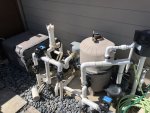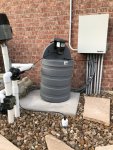Not sure if Pumps, Filters... is the right channel for this, but didn't seem to be another clear fit. As the title summarizes, I've had an inline Pentair chlorinator since install (pucks) and I'm considering/looking at switching this over to a liquid set-up. Wanted to get advice/insight from anyone at TFP who might have experience with this?
To provide some more context, I have a ~15k gal in-ground pool in Austin, TX. Equipment is mostly standard Hayward gear with some odds and ends mixed in (like the Pentair chlorinator). The pool has some overhanging/nearby tree cover, not a lot but enough that with drop and wind I get a good amount of stuff in the pool. The pool is also open year round (Texas), which leads to some secondary challenges in terms of chemistry. I have two problems that are driving this change.
1) Algae is a CONSTANT battle. Even with constant chemistry monitoring, regular brushing (including a metal brush on the plaster itself), and full blast shocking as needed (zero chlorine mvmt over multiple days) the algae returns.
2) I have to annually manage CYA due to the year round pool (no water replacement). Typically this means that sometime in May/June I switch to liquid for a 3-4 months (manually), enabling the CYA to break down in heat at a rate of about 10ppm / month. This is just irritating because I'm lazy.
I also feel like, for whatever reason, the pucks are less effective than the liquid. Whether my pucks are old/weak (I bought the lg bucket last fall, so should be fine) or pucks are just generally less effective I feel like EVERY time I switch back to pucks things get out of control, even if I'm running my chloring at 5-6ppm (with little/no pool usage).
So, does anyone have experience with going to liquid? A recommendation on a liquid chlorinator? One challenge I face is pad space... my pad is very small, so I have to find room for it. Considering some kind of platform between the heater and filter (see photo) which I would obviously make stable, but not sure if that's safe/practical.
Thanks in advance for any help!
Best,
Rick
To provide some more context, I have a ~15k gal in-ground pool in Austin, TX. Equipment is mostly standard Hayward gear with some odds and ends mixed in (like the Pentair chlorinator). The pool has some overhanging/nearby tree cover, not a lot but enough that with drop and wind I get a good amount of stuff in the pool. The pool is also open year round (Texas), which leads to some secondary challenges in terms of chemistry. I have two problems that are driving this change.
1) Algae is a CONSTANT battle. Even with constant chemistry monitoring, regular brushing (including a metal brush on the plaster itself), and full blast shocking as needed (zero chlorine mvmt over multiple days) the algae returns.
2) I have to annually manage CYA due to the year round pool (no water replacement). Typically this means that sometime in May/June I switch to liquid for a 3-4 months (manually), enabling the CYA to break down in heat at a rate of about 10ppm / month. This is just irritating because I'm lazy.
I also feel like, for whatever reason, the pucks are less effective than the liquid. Whether my pucks are old/weak (I bought the lg bucket last fall, so should be fine) or pucks are just generally less effective I feel like EVERY time I switch back to pucks things get out of control, even if I'm running my chloring at 5-6ppm (with little/no pool usage).
So, does anyone have experience with going to liquid? A recommendation on a liquid chlorinator? One challenge I face is pad space... my pad is very small, so I have to find room for it. Considering some kind of platform between the heater and filter (see photo) which I would obviously make stable, but not sure if that's safe/practical.
Thanks in advance for any help!
Best,
Rick



